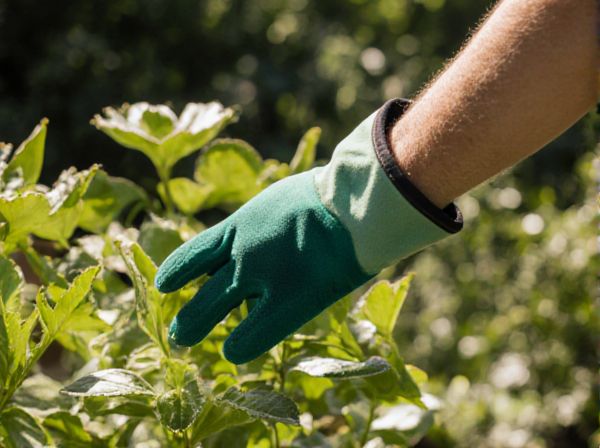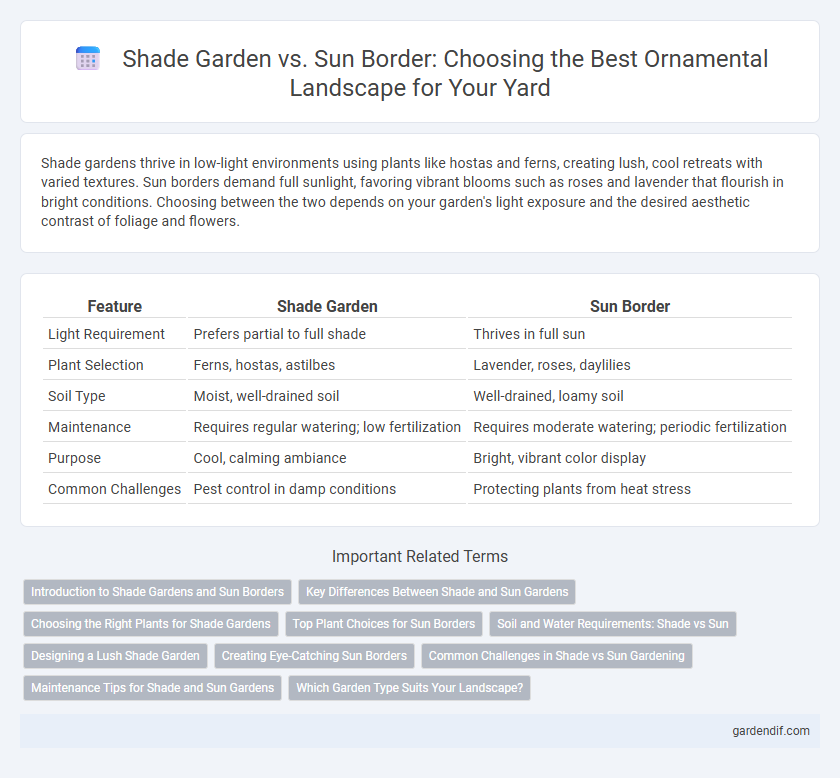
Shade Garden vs Sun Border Illustration
Shade gardens thrive in low-light environments using plants like hostas and ferns, creating lush, cool retreats with varied textures. Sun borders demand full sunlight, favoring vibrant blooms such as roses and lavender that flourish in bright conditions. Choosing between the two depends on your garden's light exposure and the desired aesthetic contrast of foliage and flowers.
Table of Comparison
| Feature | Shade Garden | Sun Border |
|---|---|---|
| Light Requirement | Prefers partial to full shade | Thrives in full sun |
| Plant Selection | Ferns, hostas, astilbes | Lavender, roses, daylilies |
| Soil Type | Moist, well-drained soil | Well-drained, loamy soil |
| Maintenance | Requires regular watering; low fertilization | Requires moderate watering; periodic fertilization |
| Purpose | Cool, calming ambiance | Bright, vibrant color display |
| Common Challenges | Pest control in damp conditions | Protecting plants from heat stress |
Introduction to Shade Gardens and Sun Borders
Shade gardens thrive in low-light conditions, featuring plants like hostas, ferns, and astilbes that provide lush foliage and delicate blooms. Sun borders are designed for areas receiving full sunlight, showcasing sun-loving perennials such as lavender, coneflowers, and daylilies for vibrant color and dynamic texture. Understanding the light requirements and plant choices is essential for creating successful ornamental landscapes in both shade gardens and sun borders.
Key Differences Between Shade and Sun Gardens
Shade gardens thrive in low-light environments, featuring plants such as hostas, ferns, and astilbes that prefer indirect sunlight and cooler temperatures. Sun borders demand full sun exposure, supporting sun-loving species like lavender, daylilies, and coneflowers that require direct sunlight for optimal growth and vibrant blooms. Soil moisture and maintenance also vary significantly, with shade gardens generally needing more consistent moisture and sun borders tolerating drier, well-drained conditions.
Choosing the Right Plants for Shade Gardens
Selecting plants for shade gardens requires focusing on species adapted to low-light conditions, such as hostas, ferns, and astilbes, which thrive without direct sunlight. Shade-tolerant perennials like hellebores and Solomon's seal provide lush foliage and seasonal color, enhancing garden texture. Avoid sun-loving plants like lavender or coneflowers that demand full sun, ensuring optimal growth and reduced maintenance in shaded environments.
Top Plant Choices for Sun Borders
Sun borders thrive with heat-tolerant perennials such as lavender, daylilies, and coneflowers, which provide vibrant color and resilience under full sunlight. Ornamental grasses like Miscanthus and fountain grass add texture and movement, enhancing visual interest in sunlit areas. Complementing these, sedums and agastache attract pollinators while requiring minimal water, making them top choices for sustainable sun borders.
Soil and Water Requirements: Shade vs Sun
Shade gardens require consistently moist, well-drained soil enriched with organic matter to support plants adapted to low light and higher humidity. Sun borders thrive in soil with good drainage and moderate moisture, tolerating periods of dryness due to higher evaporation rates under direct sunlight. Understanding these distinct soil and water needs ensures optimal growth and vibrant ornamental displays in both shaded and sunny garden areas.
Designing a Lush Shade Garden
Designing a lush shade garden requires selecting shade-tolerant plants such as hostas, ferns, and astilbes that thrive in low-light conditions, creating rich textures and layered greenery. Incorporating diverse foliage shapes and variegated leaves enhances visual interest while maximizing the limited sunlight under tree canopies. Contrasting with sun borders, shade gardens emphasize moisture-retentive soil and mulching to maintain hydration and support plant vitality in shaded environments.
Creating Eye-Catching Sun Borders
Creating eye-catching sun borders involves selecting vibrant, sun-loving plants such as lavender, coneflowers, and ornamental grasses that thrive in full sunlight. Incorporating contrasting textures and heights enhances visual interest while ensuring plants receive at least six hours of direct sun daily maximizes bloom intensity and longevity. Strategic placement of drought-tolerant perennials and seasonal flowers ensures a dynamic, colorful display that brightens the garden throughout the growing season.
Common Challenges in Shade vs Sun Gardening
Shade gardens often face challenges with limited sunlight affecting plant growth and flowering, requiring careful selection of shade-tolerant species like hostas and ferns. Sun borders demand plants that thrive in full sun conditions, such as lavender and salvia, but gardeners must manage heat stress and water retention issues. Both garden types commonly struggle with pests and soil quality, necessitating tailored soil amendments and integrated pest management strategies.
Maintenance Tips for Shade and Sun Gardens
Shade gardens require regular monitoring of soil moisture and mulching to retain humidity, as these plants often thrive in cooler, damper conditions. Sun borders demand consistent watering schedules and deadheading to promote continuous blooming, especially during peak sunlight hours. Selecting drought-resistant species for sun areas and shade-tolerant varieties for shaded spots minimizes maintenance while ensuring vibrant growth.
Which Garden Type Suits Your Landscape?
Shade gardens thrive under tree canopies or north-facing walls where sunlight is minimal, featuring plants like hostas and ferns that prefer indirect light. Sun borders suit open, south-facing spaces with abundant sunlight, ideal for sun-loving perennials such as lavender and coneflowers that require at least six hours of direct sun daily. Choosing the right garden type depends on the microclimate of your landscape, soil conditions, and the light exposure available throughout the day.
Shade Garden vs Sun Border Infographic

 gardendif.com
gardendif.com